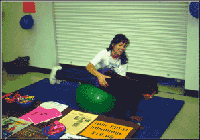|
Road trip: An Arizona OT takes her knowledge cross-country
by JESSYCA HARRINGTON
Editor
Are you listening to some soft jazz while reading this article? Do you doodle
while on the phone?
Such behaviors are a person’s way of adjusting their environment so that
he may best absorb the information that is being presented.
Different people have different sensory needs and ignoring these needs can
cause the brain to not be fully engaged. At its worst, a person actually may not
be able to concentrate without these sensory tools.
An occupational therapist from Arizona is seeking to make parents, teachers
and administrators more aware of students’ sensory needs in the classroom.
Diana Henry has long shared her knowledge of sensory processing deficiencies and
corrective occupational therapies throughout her home state of Arizona. Now, she’s
hitting the road.
Future vagabond has long history
Henry has been an occupational therapist for more than 20 years. Over the years,
she has seen many children considered behavior problems or who have been needlessly
medicated because of a sensory processing deficiency. Many children with sensory
processing deficiencies are diagnosed as ADD or ADHD.
After talking to her patients, she realized she "needed to spend more
time in schools, needed" to give students an optimal learning environment.
These classroom visits showed Henry that once taught the "teachers were better
in the classroom than the therapists." The teachers were able to give Henry
advice about possible techniques.
With these direct experiences, Henry began to develop various "tools"
for teachers to use to make their classrooms "sensory safe." Her classroom
visits eventually spread throughout the state as she was asked to give inservices
and workshops. She eventually started her own consulting company and sells various
videotapes, as well as a handbook for teachers. But these various aids haven’t
stopped districts from asking Henry for a personal visit.
With these direct experiences, Henry began to develop various "tools"
for teachers to use to make their classrooms "sensory safe."
Mobile program allows flexibility
Henry, along with her husband, has designed a program they call ATEACHABOUT.
Based on the Aboriginal idea of a walkabout, Henry’s husband – a former
marketer — came up with the idea after explaining sensory integration in
the line at the grocery store.
Tammy Wheeler MS OTR/L from Henry O.T. Services with child at a school fair.
 "He
would hear mothers saying that Ritalin doesn’t seem to be working,"
Henry said. With an increasing number of people realizing that medication is not
always the answer, the concept of a properlearning environment becomes more important.. "He
would hear mothers saying that Ritalin doesn’t seem to be working,"
Henry said. With an increasing number of people realizing that medication is not
always the answer, the concept of a properlearning environment becomes more important..
The Henrys have outfitted a fifth wheel home and intend to live in it while
teaching seminars at districts throughout the country. Henry hopes the program
will increase awareness about the need for sensory integration in classrooms.
As well, ATEACHABOUT gives greater flexibility in scheduling.
Continued here
For more information about ATEACHABOUT, contact Diana Henry at (888) 371-1204
or visit the Web site: www.henryot.com.
Reprinted with permission from Counterpoint. Copyright 2000 by LRP Publications,
747 Dresher Road, PO Box 980, Horsham, PA 19044-0980. All rights reserved. For
more information on products published by LRP Publications, please call 800-341-7874,
ext. 275 or visit Education Administration Online -LRP Publications' electronic
network of education resources at http://www.lrp.com/ed.
Return to Articles Index Page
Henry OT Services, Inc
4000 Pipit Place, Flagstaff, AZ 86004
E-Mail: rick@henryot.com
|

